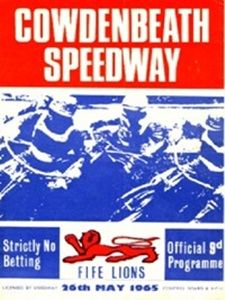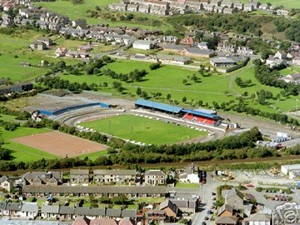
| Home | Contact Us | Articles |
| Books - DVDs | Stadia Pix | Programme Generator |
Cowdenbeath Speedway 1965
By Mark Dell

Reading the 1965 World Final programme recently from Wembley (won by Bjorn Knutsson incidentally) I noticed that the five preliminary rounds to get to the Wembley showdown were held on non-league, open licence tracks. Middlesbrough, Rayleigh, Ipswich, King's Lynn were four familiar names, but the fifth really stood out as I had never heard of COWDENBEATH SPEEDWAY before.
I went to my small library of reference books and found both of them immediately. The 1966 British Speedway Handbook did indeed list eight meetings at the newly opened Cowdenbeath track, one of which was the World Championship preliminary round on 26 May. The other book was the invaluable Homes of British Speedway by Bamford and Jarvis which told me that the track was located at Central Park, the home of Cowdenbeath F.C., then in Scottish Division Two, and now known as the Blue Brazil, because they play in blue and reportedly have the same amount of debt as Brazil! However, the venture was not a success and only lasted until 17 July 1965, the track was later covered in tarmac, and stock car meetings are still held there.
Bamford and Jarvis informed me that the operation was run by the legendary showman Johnnie Hoskins and the first meeting was Wednesday 5 May when the Fife Lions, as the team were known, defeated the Colonial Tigers 44-33 in a challenge match. This was just the bare bones of the story so after some further research and the purchase of some Cowdenbeath programmes on eBay I knew a little more of its history.
The track was 380 yards long and the fastest time of the night at that first meeting was set in Heat 1 by the Glasgow Tiger and visiting skipper, Australian Bluey Scott in a time of 70.4 seconds. Scott was mentioned in the programme as being the big danger and so he proved with a 12-point maximum. Doug Templeton set a four laps flying start record of 67.4 seconds, just beating George Hunter's time of 67.8. The scores for the Fife Lions were Willie Templeton 10+2, Alec Hughson 1, Bill Landels 8, Bill McMillan 6+2, Bert Harkins 9, Jimmy Tannock 6+2 and Red Monteith 4. The visitors used nine riders, one of whom was Dave Gifford who scored 1 point. Scott was the only visitor to record double figures.
For the second meeting against a Newcastle Select a week later, three of the Colonial Tigers of the previous week (Kevin Torpie, Bluey Scott and Ross Nickisson) were lining up for the Fife Lions in a 43-35 victory over the Diamonds. This was one of the problems at Cowdenbeath, of borrowing riders from other clubs. They intended to develop their own talent with a view to entering the British League and Hoskins thought there was definitely a viewing public to support the team and rather optimistically in his programme jottings for Saturday 17 July, suggests league speedway would be possible on crowds of 4,000. Sadly that was to be the last meeting at the track, but who knows if the 2nd Division had been formed for 1966 instead of 1968, perhaps Cowdenbeath would have been competing with the likes of Rayleigh, Nelson and Berwick, and that would have been more sustainable with the reduced pay rates in the lower division.
Cowdenbeath staged the fourth of the World Championship preliminary rounds on 26 May. The meeting was won by Russ Dent of Newcastle with a 15 point maximum against a field of mainly Glasgow, Edinburgh and Halifax riders, with Bruce Ovenden second and Graham Coombes third (both Glasgow riders). Dent had tuned up for this meeting by scoring 12 from five rides in Newcastle's visit to Central Park two weeks earlier. Dent went on to score seven, seven and eight in his three qualifying rounds at Belle Vue, Sheffield and Glasgow respectively.
Another problem for Cowdenbeath it seems was getting the race night right, as they could not race on Saturday because that was Edinburgh's night at Old Meadowbank and Friday night was Glasgow at the White City. So they stuck with Wednesday apart from two Saturday meetings and maybe this was part of the reason for the track's demise. The 1966 Speedway Handbook suggests Cowdenbeath should have been to Scotland what King's Lynn was to England - a completely new and successful track. However, it did remain open for training in the winter of 1965-66 but then seems to have closed for good.
For the record, these were the results from the 1965 season:
5 May - Fife Lions 44 Colonial Tigers 33
12 May - Fife Lions 43 Newcastle Select 35
19 May - Fife Lions 38 Halifax Select 40
26 May - World Champs Preliminary Round - Russ Dent (Newcastle) 15 pts
5 June - Scottish Junior Championship - Bill McMillan (Glasgow) 12 pts
9 June - Fife Lions 35 The Rest 41
16 June - Fife Lions 42 Charlie Monk Select 36
17 July - Fife Lions 42 Rest of Scotland 35

Cowdenbeath Averages:
(qualification 2 matches)
|
Matches |
Rides |
Points |
Bonus |
Total |
CMA |
|
|
Willie Templeton |
6 |
25 |
61 |
2 |
63 |
10.08 |
|
Bill Landels |
4 |
16 |
33 |
2 |
35 |
8.75 |
|
Bluey Scott |
5 |
21 |
42 |
2 |
44 |
8.38 |
|
Bert Harkins |
5 |
20 |
35 |
4 |
39 |
7.80 |
|
Ross Nickisson |
3 |
8 |
8 |
5 |
13 |
6.50 |
|
Bill McMillan |
3 |
13 |
18 |
2 |
20 |
6.15 |
|
Red Monteith |
2 |
5 |
6 |
0 |
6 |
4.80 |
|
Kevin Russell |
3 |
10 |
7 |
2 |
9 |
3.60 |
Sources:
1966 British Speedway Handbook
Homes of British Speedway (2001) Robert Bamford and John Jarvis
Cowdenbeath Speedway programmes 1965
The Complete History of the British League (1991) Peter Oakes
1965 complete match details from the Speedway Researcher website.
Black Diamonds and The Blue Brazil (1993) Ronald Ferguson
Speedway in Scotland (2001) Jim Henry and Ian Moultray
This article was first published on 23rd July 2009

"Ian Hawkins states that it must have been terrifying for the track staff having to encounter Bill Landels' riderless bike - probably only slightly more frightening that when Bill was on board. Bill was an exciting, fearless rider - bike control did not appear to be uppermost in his mind. I seem to recall that he won the Scottish Open Championship from Charlie Monk and a lot of other top class riders. The track was so wet that only a 'crazy horse' would commit fully to racing. Unfortunately, when the tracks were normal Bill struggled at reserve - still giving 110% and terrifying all around him. I believe that Bill retired emigrated to Australia circa 1970."
"Whilst working in Scotland around 3 years ago on one cold winter Tuesday evening I went to a football match at Cowdenbeath. The Speedway track was still in place, now tarmaced for stock car racing, 40 years after the last Speedway race. You can only imagine how things were but from memory similar to the Shay at Halifax in terms of Track, Football Pitch and Stands. "
"Re the track at Cowdenbeath: It was Dick Campbell and my father who made the track for speedway for Jonnie Hoskins. I remember it as I got a lift back to Edinburgh with Dick in a jag. When we hit a ton the door clicked open on to the first catch but went no further. The machine used was a Gallion Grader similar to cats etc used today."
"Cowdenbeath was notable for two reasons - the furthest North track in the U.K. and that its "safety" fence was a brick wall! The other incident I remember was when Bill Landels fell, but his bike carried on riderless for about half a lap - quite exciting but very scary for track staff. The stock car track has now closed and relocated to Lochgelly."
"Edinburgh raced on Saturdays in 1965 and while Glasgow were Wednesday nights then so Cowdenbeath had the pick of the rest. The stadium was used for training for a spell. The only two Fife assets were Ross Nickisson and Kevin Russell. Ross had spell at Edinburgh after Cowdenbeath closed but did not return. Cowdenbeath is the most northern speedway tack in the UK ever. I saw the last meeting."
"Racenight for Edinburgh and Glasgow is round the wrong way. White City operated on a friday night and Old Meadowbank a saturday night."
"Good article. I seem to recall reading that the track record was held by Bill McMillan' elder brother of Jimmy Mac. One small point regarding the race night - Glasgow were the Friday track and Edinburgh were Saturday. Fife had a reasonably good grasstrack base and may have provided a few riders and a reasonably decent level of support if, as Mark suggests, there had been a lower league."
"I was at two of these meetings as a wide-eyed 11 yer old, including the World Champs prelim won by Russ Dent. We were all big Monarchs fans, and I remember the riders willingness to sign autographs without having to queue by the pits for ages! Sadly the programmes are long gone, but I still have one of the few FiFe Lions metal badges. "
"I remember very well the first practice at the track. Charlie Monk was the first man on the track and promptly fell off at the first bend as the track was so slick. I am happy to say I still have my first cheque from there for a second half ride which I did not finish, the is made out for seven shillings and sixpence (37.5p) which was the starting money, ten shillings less 2 shillings and sixpence for fuel. Happy days."
"I was one of a sizeable contingent of Edinburgh Monarch's fans who made the short rail journey over the Forth Bridge to attend meetings at Central Park. Attendances were reasonable to start with but soon dropped off. I don't think there was ever much of a local fanbase and the venture was probably doomed from the start. There was a large main stand and some terracing but many spectators watched from grass banking."